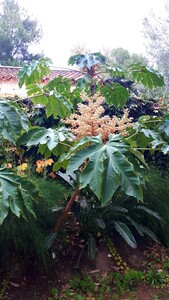Tetrapanax Papyrifer (Rice paper plant)
Presentation
At the origin of rice paper!
This perennial shrub is an endemic species originating from the island of Taiwan and South China. Its stems have been used to produce rice paper for thousands of years.
Thanks to its resistance and elasticity when moist, rice paper is widely used for both decorative purposes and for the manufacture of traditional hairpins.
But rice paper is especially renowned for its use as a media for Chinese paintings.
In the West, this species is generally grown as an ornamental plant – that is how we use it at our four-star campsite Les Jardins de La Pascalinette ®, where we simply enjoy admiring it 🙂
A touch of botany for plant lovers…
Belonging to the Araliaceae plant family, the Rice paper plant can reach from 3 to 7 metres in height. Its umbels, comprising little white flowers, develop in autumn, for the greatest pleasure of our bees who appreciate its melliferous properties. Its exuberant, green and graphic leaves spread out in fan shapes and can reach up to 50 centimetres in width!
The Rice paper plant requires a semi-shaded location to be completely at ease and must be protected from the wind to avoid its large leaves getting torn.
Where to find it at the campsite
Easy to maintain and fairly rustic, the Rice paper plant does well in the climate of the Var area, French Riviera-Côte d’Azur and is particularly at ease at our beautiful campsite!
You will find the Rice paper plant in the garden of our Coin des Copains® Friends Corner (nr 9 on the campsite’s Décou’Verte® botanical footpath plan), and “Jardin du Levant” (n° 22).
Identity
| Latin name : | Tetrapanax papyrifera |
|---|---|
| Family : | araliaceae |
| Genus : | Tetrapanax |
| Species : | papyrifera |
| Color : | Green leaves, white flowers |
| Origin : | Taiwan, South-East Asia |
| Foliage : | Lush |
| Port : | Semi-shrub, semi-hardy |
| Height : | Up to 5 m |
| Flowering : | October to January |
Did you know?
The Tetrapanax Papyrifer (Rice paper plant) is particularly used in traditional Chinese medicine to favour the elimination of toxins and purification of the organism.





